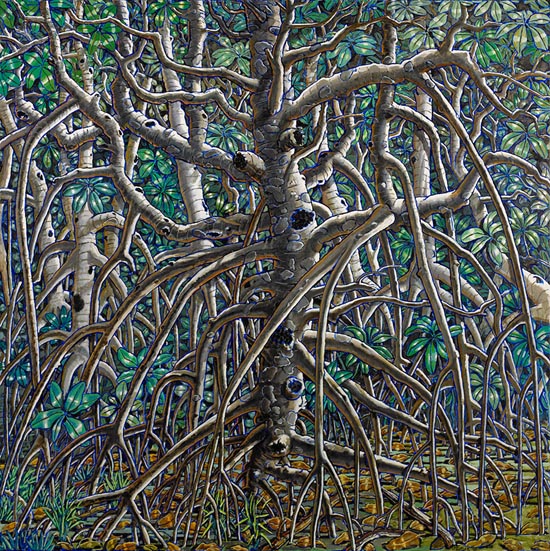 |
| Jerry Cutler, Big Man |
What is a typical day like in your studio? When do you arrive? Do you have a plan or do you dive right in?
I get into the studio around ten-ish. Because I have several pieces baking in the oven, I go from one to another. As one gets close to be finished there are several more ready to work on.
Your subject matter has changed in your most recent work. Can you talk a little about your creative process? How does your work unfold? Do you start with sketches or have a clear idea of what you want to achieve with each work?
Sketchbooks are very important part of the making of a painting. I have many sketchbooks of varied sizes. I keep the sketchbooks over time so I can pull out ideas. I work the sketchbooks, finding ideas that might work for a painting.
Everything starts with sketches and drawings in the many sketchbooks that pile up on my studio table. I have many cardboard boxes of sketchbooks, each one labeled for the start and ending of each book.
You've been painting the Florida landscape for a while and I know you have a strong interest in the environment. Did one interest come first or did they evolve together?
I’ve always been interested in the eroding environment. I’ve been interested in the Florida or all treed landscapes for 15 years. A number of years ago I invented the Sylyan man & Woman. These figures are sent out to preach the word of conservation and all of the issues thereof. Among the issues are Clear Cutting, Constant Housing and Building, Lack of Support for all Issues of Conservation, and most of all the Over-riding Issue of the Global Heating of the Atmosphere Bearing us Down.
Who were you’re earliest influences? Did you know you wanted to be an artist? Did you begin in painting?
I cannot remember a time that I didn’t draw. Every scrap of paper was drawn on. I didn’t paint until one of my aunts gave me a small kit of paints and brushes. This would be probably be when I was around ten years old. About then, I was staying at my aunt and uncle from Indiana. They took me to the Chicago Art Institute. That opened my eyes as to what art could be.
Have your influences changed much over time? Do you look at the same artists you started with or has that list changed over time?
I suppose that when I was working on my Bachelor of Art degree, I was exposed to the latest and most talked about artists such as the California painters such as David Park, Nathan Oliverio, Elmer Bishoff, etc.
More recently, I don’t rely so much on what other painters as I have plowed a furrow that is, I believe, succinctly my own inventions.
Do you ever find yourself in a creative dry spell? If so, what do you do to find your way through and create new work?
I don’t think I have ever had a dry spot to attend with, thank the lord. I believe that is because I am such a believer of sketchbooks. I recommend taking a sketchbook everywhere you go. Don’t worry about how good or bad the sketches are. For instance, I went along with my wife as she was looking for something to bolster her closet. Generally, I would be bored to death, but with a small sketchbook handy, I can draw people (thanks for gesture drawing), architecture, the clothes hanging on the rods, etc.
I know this is a perennial question, but how do you know a painting is finished?
This is a hard and difficult thing to deal with. I spend an extraordinary time as I look at the painting over and over again. I like the trick of looking at the image with a mirror- It gives you a new perspective. Mostly, when I feel that the work is done, I do not mess with it. I may sell it, give it away, put it in storage, or eventually destroy it.
If you could recommend a reading or a book for artists what would it be?
Mostly, I like to buy or borrow large coffee table books as the images are large and mostly well done. As for reading about what is going on in the art world, I don’t bother with them much. I guess if I was still teaching I would recommend some, but I am retired now.
If anyone is interested of the books I read when I was at the university, I would suggest books like “Notes to a Young Painter” by Hiram Willams, “The Shape of Content” by Ben Shahn, “Point and Line to Plane” by Wassily Kandinsky, and Heinrich Wolfflin”s “Principles of Art History.”
What are you working on right now?
In the latest work I am working many different angles of what I call “the Sylvan People.” I am always looking at pieces of wood that I can use as 2- D material to form images of a woody anatomy.



